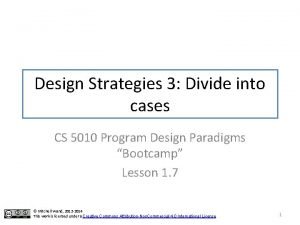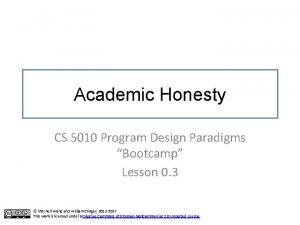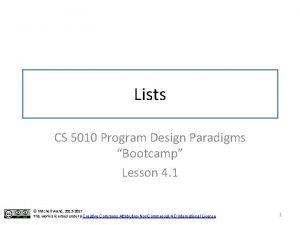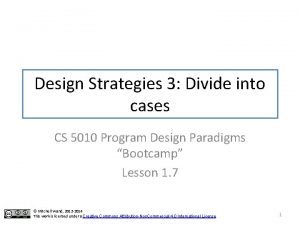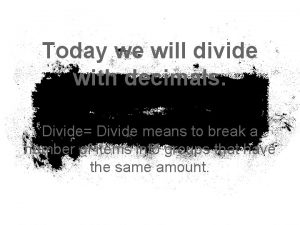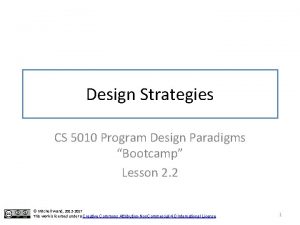Design Strategies 3 Divide into cases CS 5010










- Slides: 10

Design Strategies 3: Divide into cases CS 5010 Program Design Paradigms “Bootcamp” Lesson 1. 7 © Mitchell Wand, 2012 -2014 This work is licensed under a Creative Commons Attribution-Non. Commercial 4. 0 International License. 1

Data Representations Design Strategies Basics Combine simpler functions Mixed Data Use a template Recursive Data Lesson 2. 1 Generalization Over Constants Over Expressions Divide into Cases Functional Data Objects & Classes Stateful Objects Over Contexts Call a more general function Communicate via State Over Data Representations Over Method Implementations 2

Divide into cases on <condition> • Sometimes you need to break up an argument in some way other than by its template. • We already saw this in Lesson 0. 4 in the definition of abs: ; abs : Real -> Real ; RETURNS: the absolute value of the given real number. ; STRATEGY: divide into cases on sign of x (define (abs x) (if (< x 0) (- 0 x) x)) 3

Example: income tax • Imagine we are computing income tax in a system where there are three rates: – One on incomes less than $10, 000 – One on incomes between $10, 000 and $20, 000 – One on incomes of $20, 000 and over • The natural thing to do is to partition the income into three cases, corresponding to these three income ranges. 4

Write a cond or if that divides the data into the desired cases ; ; STRATEGY: Cases on amt ; ; f : Non. Neg. Real -> ? ? (define (f amt) (cond [(and (<= 0 amt) (< amt 10000)). . . ] [(and (<= 10000 amt) (< amt 20000)). . . ] [(<= 20000 amt). . . ])) 5

Write a cond or if that divides the data into the desired cases ; ; tax-on : Non. Neg. Real -> Non. Neg. Real ; ; GIVEN: A person’s income This is contract is sloppy. Currency ; ; RETURNS: the tax on the income amounts should never be Real. ; ; EXAMPLES: . . They should always be integers, ; ; STRATEGY: Cases on amt and units should be specified. But we don't need to be so careful for (define (tax-on amt) this made-up example. (cond [(and (<= 0 amt) (< amt 10000)). . . ] [(and (<= 10000 amt) (< amt 20000)). . . ] [(<= 20000 amt). . . ])) The predicates must be exhaustive. Make them mutually exclusive when you can.

Now fill in the blanks ; ; ; ; ; tax-on : Non. Neg. Real -> Non. Neg. Real GIVEN: A person’s income RETURNS: the tax on the income EXAMPLES: . . STRATEGY: Cases on amt (define (tax-on amt) (cond [(and (<= 0 amt) (< amt 10000)) 0] [(and (<= 10000 amt) (< amt 20000)) (* 0. 10 (- amt 10000))] [(<= 20000 amt) (+ 1000 (* 0. 20 (- amt 20000)))])) That's all you need to do!

Another example ; ; ball-after-tick : Ball -> Ball ; ; STRATEGY: cases on whether ball would hit the wall on ; ; the next tick (define (ball-after-tick b) (if (ball-would-hit-wall? b) (ball-after-bounce b) (ball-after-straight-travel b))) 8

Where does cases fit in our menu of design strategies? • If you are inspecting a piece of enumeration or mixed data, you almost always want to use the template for that data type. • Cases is just for when dividing up the data by the template doesn't work. 9

Next Steps • If you have questions or comments about this lesson, post them on the discussion board. • Go on to the next lesson 10
